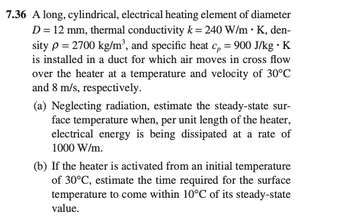
Elements Of Electromagnetics
7th Edition
ISBN: 9780190698614
Author: Sadiku, Matthew N. O.
Publisher: Oxford University Press
expand_more
expand_more
format_list_bulleted
Question
thumb_up100%

Transcribed Image Text:7.36 A long, cylindrical, electrical heating element of diameter
D = 12 mm, thermal conductivity k = 240 W/mK, den-
sity p = 2700 kg/m³, and specific heat cp = 900 J/kg . K
is installed in a duct for which air moves in cross flow
over the heater at a temperature and velocity of 30°C
and 8 m/s, respectively.
(a) Neglecting radiation, estimate the steady-state sur-
face temperature when, per unit length of the heater,
electrical energy is being dissipated at a rate of
1000 W/m.
(b) If the heater is activated from an initial temperature
of 30°C, estimate the time required for the surface
temperature to come within 10°C of its steady-state
value.
Expert Solution
This question has been solved!
Explore an expertly crafted, step-by-step solution for a thorough understanding of key concepts.
This is a popular solution
Trending nowThis is a popular solution!
Step by stepSolved in 2 steps

Knowledge Booster
Learn more about
Need a deep-dive on the concept behind this application? Look no further. Learn more about this topic, mechanical-engineering and related others by exploring similar questions and additional content below.Similar questions
- The thermal boundary layer in heat transfer exists whenever there is a difference between the temperatures of the fluid and the outside environment. For fluid flow, how does a boundary layer form?A. Because common surfaces are not smooth, the flow is hindered, and boundary layers are formed.B. The disturbances on the streamlines in high Reynolds number flow produces boundary layer.C. The existence of walls or “boundaries” that keep the fluid inside (or outside) creates the boundary layer.D. Velocity profiles are inherently approaching no-slip condition because of the resistance of the walls.arrow_forwardQ1/ Consider the following fluids, each with a velocity of u = 9 m/s and a temperature of 10°C, in cross flow over a 10-mm diameter cylinder maintained at 50°C. Calculate the rate of heat transfer per unit length for saturated water? ***** 2 Satu Dety PP Liquid 3149 9920 4.246 996.0 528 9040 7.354 902.1 393 9901 Nu 0.3+1 Endalay Specific Heal Veputation 0.62 Re2 Pro [1 + (0.4/Pypa[1+ (282,000) aper 0.0231 2402 4180 00304 4378 0.0397 2419 4178 0.0612 2407 4179 00655 2335 4180 tree Thermal Coductivity THAY Liquid Vapor Le Dynamic Vacosity 1870 Vapor Liquid 0607 0.0186 0110 0.90710 1875 0615 0.0169 0.796 101 100110 1880 BAZ3 0.0192 0720x10 1016 10 1825 0.631 0.5196 0653x10 103150 1832 0437 0.0000 0596x10104610 Fran www. Lignon A'IN Ligad Vaper 614 1.00 0.24710 542 100 0234-10 4.83 1.00 0.337x10 4.32 100 0377x10 191 100 0415-10arrow_forwardTypically, air is heated in a hair dryer by blowing it across a coiled wire through which an electric current is passed. Thermal energy is generated by electric resistance heating within the wire and is transferred by convection from the surface of the wire to the air. Consider conditions for which the wire is initially at room temperature, T;, and resistance heating is concurrently initiated with airflow att = 0. q Air Too, h 001 Coiled wire (ro, L, k, p, cp) 0000 Pelec Airflow ווי SUarrow_forward
Recommended textbooks for you
 Elements Of ElectromagneticsMechanical EngineeringISBN:9780190698614Author:Sadiku, Matthew N. O.Publisher:Oxford University Press
Elements Of ElectromagneticsMechanical EngineeringISBN:9780190698614Author:Sadiku, Matthew N. O.Publisher:Oxford University Press Mechanics of Materials (10th Edition)Mechanical EngineeringISBN:9780134319650Author:Russell C. HibbelerPublisher:PEARSON
Mechanics of Materials (10th Edition)Mechanical EngineeringISBN:9780134319650Author:Russell C. HibbelerPublisher:PEARSON Thermodynamics: An Engineering ApproachMechanical EngineeringISBN:9781259822674Author:Yunus A. Cengel Dr., Michael A. BolesPublisher:McGraw-Hill Education
Thermodynamics: An Engineering ApproachMechanical EngineeringISBN:9781259822674Author:Yunus A. Cengel Dr., Michael A. BolesPublisher:McGraw-Hill Education Control Systems EngineeringMechanical EngineeringISBN:9781118170519Author:Norman S. NisePublisher:WILEY
Control Systems EngineeringMechanical EngineeringISBN:9781118170519Author:Norman S. NisePublisher:WILEY Mechanics of Materials (MindTap Course List)Mechanical EngineeringISBN:9781337093347Author:Barry J. Goodno, James M. GerePublisher:Cengage Learning
Mechanics of Materials (MindTap Course List)Mechanical EngineeringISBN:9781337093347Author:Barry J. Goodno, James M. GerePublisher:Cengage Learning Engineering Mechanics: StaticsMechanical EngineeringISBN:9781118807330Author:James L. Meriam, L. G. Kraige, J. N. BoltonPublisher:WILEY
Engineering Mechanics: StaticsMechanical EngineeringISBN:9781118807330Author:James L. Meriam, L. G. Kraige, J. N. BoltonPublisher:WILEY

Elements Of Electromagnetics
Mechanical Engineering
ISBN:9780190698614
Author:Sadiku, Matthew N. O.
Publisher:Oxford University Press

Mechanics of Materials (10th Edition)
Mechanical Engineering
ISBN:9780134319650
Author:Russell C. Hibbeler
Publisher:PEARSON

Thermodynamics: An Engineering Approach
Mechanical Engineering
ISBN:9781259822674
Author:Yunus A. Cengel Dr., Michael A. Boles
Publisher:McGraw-Hill Education

Control Systems Engineering
Mechanical Engineering
ISBN:9781118170519
Author:Norman S. Nise
Publisher:WILEY

Mechanics of Materials (MindTap Course List)
Mechanical Engineering
ISBN:9781337093347
Author:Barry J. Goodno, James M. Gere
Publisher:Cengage Learning

Engineering Mechanics: Statics
Mechanical Engineering
ISBN:9781118807330
Author:James L. Meriam, L. G. Kraige, J. N. Bolton
Publisher:WILEY